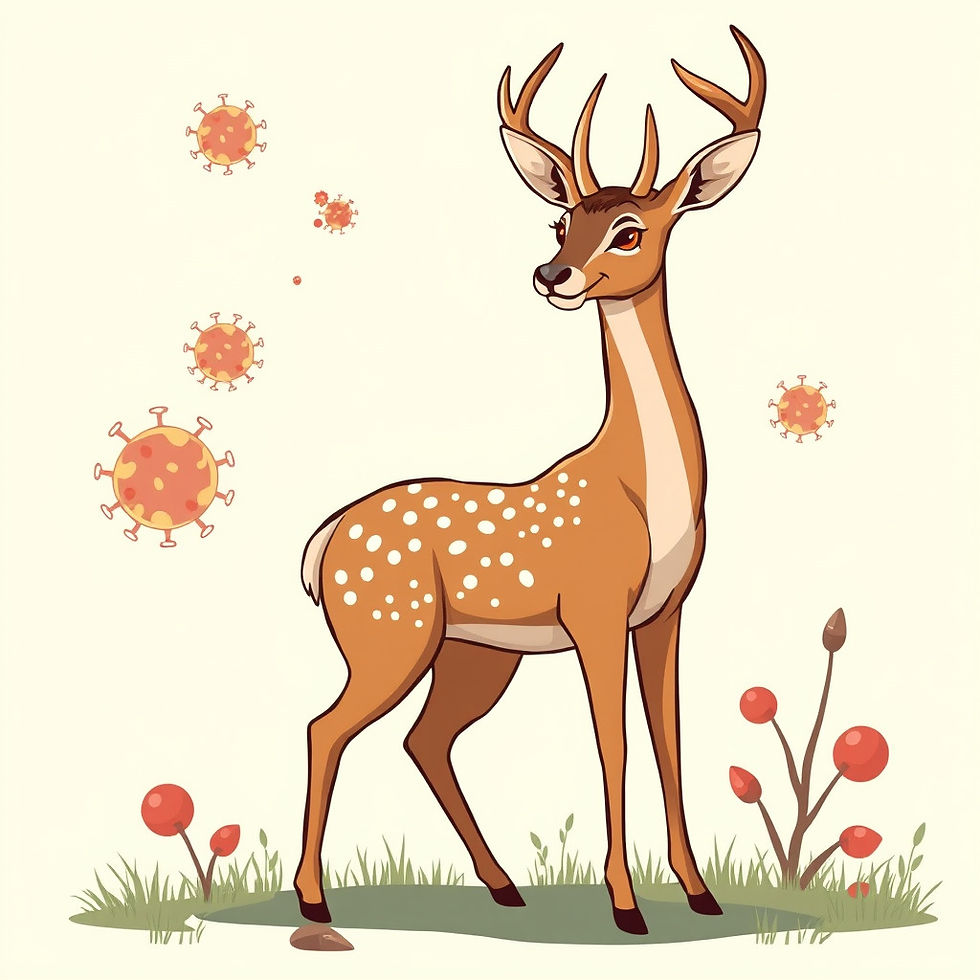
27 juni 2025
Perez et al. (BioRxiv)
Keywords
SARS-CoV-2
roe deer
spill-over, spill-back
zoonoses
Main Findings
In this preprint, Perez et al. track the prevalence of SARS-CoV-2 infection in roe deer populations over several years (2010-2022) using both serological tests (ELISA, Sero- neutralization) and direct RT-PCR testing giving reliable insights into virus exposure trends. The study investigates different deer populations in several regions in France, tracking individual roe deer over multiple years (from 2010-2022), to allow the researchers to examine seroprevalence before and after COVID-19 emergence in France. The study demonstrates that wildlife might serve as a SARS-CoV-2 reservoir, which is important information for managing future outbreaks. Main results:
The study found no direct indication of the presence of SARS-CoV-2 by RT-PCR of nasal swabs in roe deer populations in France.
Serologic tests revealed a low seroprevalence of SARS-CoV-2 antibodies (2.20%); however, this result could be due to cross-reactivity with antibodies against other coronaviruses—most likely bovine coronavirus (BCoV), which is common in cattle, rather than exposure to different SARS-CoV-2 variants (e.g., Omicron, Delta), which might indicate that detected antibodies might not reflect actual SARS-CoV-2 infection.
Generally, the authors concluded that no significant virus transmission from humans to roe deer was detected in the studied populations.
Limitations & Suggestions
To study spillover (human to animal) and spillback (animal to human) of viruses in wildlife populations is important, especially since there have been limited studies in European on how such transmissions may occur in roe deer. However, the low percentage of positive serological results (ca. 2%) only permits partial conclusions regarding the spread of the virus in roe deer populations. Investigating other potential tracks of transmission including environmental factors (e.g. food intake, social behaviour of the animals within the herd, habitat characteristics etc.), could provide a more comprehensive understanding of SARS-CoV-2 spillover to wildlife.
The results suggest seroprevalence in roe deer but may indicate cross-reaction with another coronavirus. In addition, the absence of direct detection of SARS-CoV-2 RNA in nasal swabs may suggest minimal or no virus transmission to deer. Conducting genetic analyses of the virome from wildlife and domestic animals could help identify potential viral mutations (e.g. maybe that could be the reason why the qRT-PCR did not detect any SARS-CoV-2 viruses) and track viral changes across species.
While covering several regions, the study is restricted to roe deer populations in France, limiting the applicability of the results to other regions or species. Maybe including a broader range of species and regions could help to better understand the virus spread in wildlife populations If this is feasible, ongoing surveillance could enormously help to track any potential emergence of the virus in wildlife populations not only from governmental agencies but also for farmers and hunters (e.g. intra and inter sampling campaigns of serum/ nasal swab across different wildlife reservoir hosts to build up a data base for continuous monitoring).
Significance/Novelty
Based on this preliminary publication, the study explores the prevalence of SARS-CoV-2 in wild populations of roe deer in several regions in France, a species that has not previously been investigated for this virus. The study identifies wildlife as potential hosts for SARS-CoV-2, providing new insights into the role of human-wildlife interactions in virus transmission.
The study contributes towards future research on zoonotic transmission and non-human virus hosts to develop vaccines and prevention strategies. It highlights the risk of potential virus transmission for those in contact with wildlife and emphasizes the need for wildlife surveillance to prevent possible future outbreaks.
Credit
Reviewed by Dominik-A Kugler as part of a cross-institutional journal club between the Max-Delbrück Centre Berlin, the Ragon Institute Boston (Mass General, MIT, Harvard), the Medical University of Vienna and other life science institutes in Vienna.
The author declares no conflict of interests in relation to their involvement in the review.
